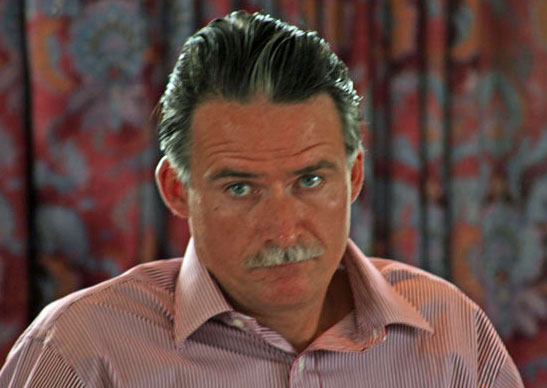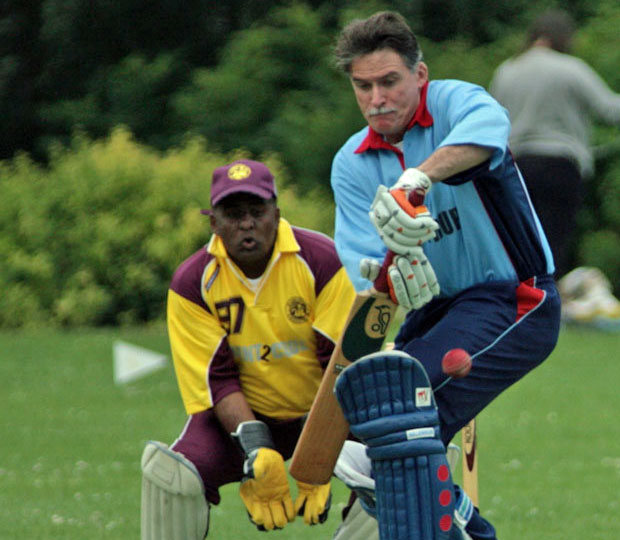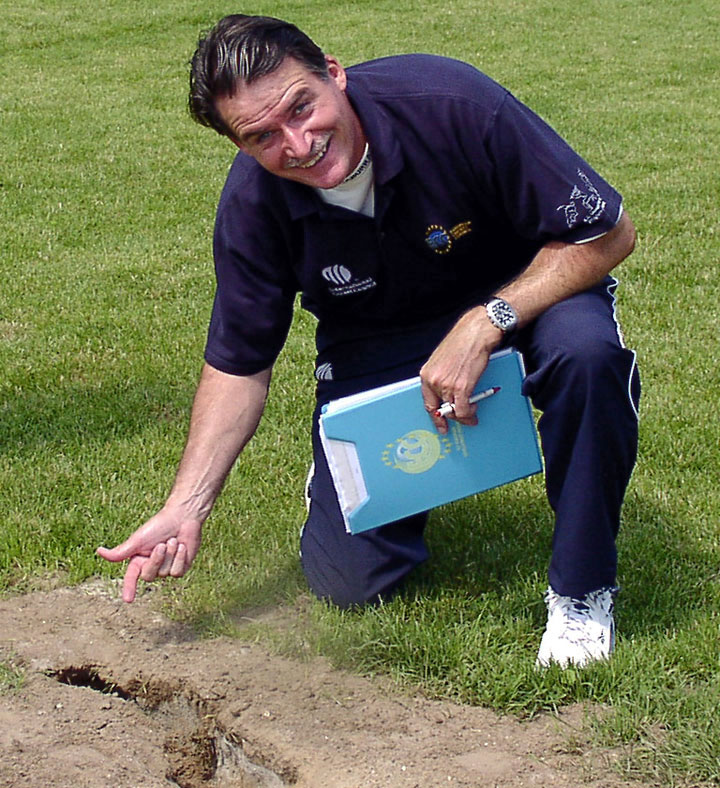Towering six feet four inches tall and chiseled from granite like a Viking warrior of old, Ole Mortensen was a familiar sight in the Derbyshire side for more than a decade.
Nicknamed ‘Stan’, after the famous footballer, or ‘Blood-Axe’, he claimed 653 wickets for East Midlanders, helping the club to victories in the 1990 Sunday league and 1993 Benson & Hedges Cup.

Mortensen, who made his debut for his native Denmark aged just 17, was such a prolific performer in the one-day game that he was sounded out to represent England in the 1980s, by then captain Mike Gatting.
“I was approached to ascertain my views and ambitions,” he said. “I was certainly open to the idea, but for whatever reason, be it politics or something else, it never materialized.”
Now 62, the Great Dane reflects how a former tax inspector from Jutland went on to become one of the most recognizable characters on the county scene.
“My introduction to the county game came as a result of English professionals coming over to Denmark to take coaching sessions and my potential was spotted. Danish cricket sent youth tours to Essex every summer and that was the other opportunity for me.
“I was initially an all-rounder but developed primarily into a fast-medium swing bowler and that was the aspect the counties were most interested in.”
Initially Mortensen was classified as an overseas player, making it incredibly difficult to get a contract, given the depth and quality of overseas players available at the time.
 © Peter Power
© Peter Power
“I did have a trial with Northumberland when they were a minor county but when I got in touch with the Championship sides I was up against players like Imran Khan, Garth Le Roux, Richard Hadlee and guys of that calibre. Not easy!
“My big break came when an MP took a case to the UK Parliament for freedom of labour [as a European citizen] – eventually winning after an 18-month battle, which meant that I then became classified as a local.
“I contacted the counties again and two offered trials: Derbyshire and Kent. My original plan was to fly to Derby, spend a week on trial there, and then drive to Kent for the second week where I was to meet Brian Luckhurst.
“In the event I never made it to Kent as Ian Buxton at Derbyshire offered me a deal which I accepted.
“At the time I was 25, so perhaps a little old to be starting off. I had a full-time job as a tax collector so my family was in two minds. They understood I was following my dreams but at the same time considered me a little insane.
“I thought I would get to spend a year or two at Derbyshire, then be back collecting revenues in Copenhagen. I didn’t think that it would last for 11 or 12 years for sure.”
There were many highlights in his time at The County Ground but one that sticks out was his first match at Trent Bridge against a star studded Nottinghamshire side.
“Rain meant we lost nearly a day and a half, but getting the opportunity to bowl at guys like Derek Randall, Clive Rice and Richard Hadlee in my maiden first-class match was exceptional.
 © Peter Power
© Peter Power
“I was also playing with England internationals Geoff Miller, Kim Barnett – who was captain – and my wicket-keeper was Bob Taylor.
“Bob was outstanding. He had a computer-like brain and knew the strength and weaknesses of all the 297 first-class cricketers. He was a big help to me in the first few years getting established in the Derby set-up.”
Mortensen claimed 66 wickets in his debut season, including a match haul of 11 for 89 against Yorkshire. Derbyshire won by 22 runs despite an unbeaten 112 from Geoff Boycott, who carried his bat in the second innings.
Although he didn’t claim Boycott’s scalp in that game, he did soon after much to the annoyance of the White Rose supporters.
“We were playing Yorkshire in a John Player League game at one of the out grounds on a glorious Sunday afternoon and it was packed to the rafters, all coming to see Geoffrey bat. Yorkshire won the toss but I hadn’t read the script.
“As the huge crowd were getting out their picnics and drinks in anticipation of Geoffrey getting a lot of runs, I dismissed him with my second ball. Big mistake!
“When I went to field on the boundary, they were screaming at me: ‘What the eff is going on ’ere lad? We came to see Sir Geoffrey. Not some bloody Viking taking wickets…’”
Mortensen settled into life in Derbyshire but his loyalty was soon tested when an offer to double his money came from Northants, who were sponsored by Carlsberg.
The Danish brewing giants wanted him as their poster boy, but ‘Stan’ opted to remain put due to the influence of West Indian fast-bowling great Michael Holding.
“I had the chance at Derbyshire to open the bowling with Michael Holding for seven years. He was my mentor and simply fantastic to play with. We became friends and still stay in close contact.
“While he was known as the Rolls Royce of bowlers, I suppose I was more of a Robin Reliant! We were a deadly combination, though.”
Mortensen’s loyalty was rewarded with a testimonial in 1994, with supporters and volunteers producing a “beautiful brochure” and arranging many events and dinners, culminating in a special evening in the Long Room at Lord’s.
“I had a great rapport with the Derbyshire supporters who loved my Viking image,” he said. “That’s one of the mistakes of county cricket now, the absence of real characters in the game. They all run around like robots now.
 © Peter Power
© Peter Power
“I was fortunate to play in an era with so many greats. Malcolm Marshall, Gordon Greenidge, Wayne Daniel, Sylvester Clarke, Clive Rice, Richard Hadlee, Javed Miandad, Andy Roberts, Ian Botham, Imran Khan, Joel Garner, Viv Richards and others. All these legends who it was great to compete against.
“After the games, home and away, the sponsors would invite us all for a drink and I learned so much as a rookie just listening to these players talking. That’s lost nowadays, with players just going straight back to the hotel. They’re missing out on so much.”
Cricket quickly became an all-year round occupation as ‘Blood-Axe’ spent a winter in Auckland, followed by ten seasons in Melbourne, crossing swords with the likes of Allan Border, Merv Hughes, Simon O’Donnell and Terry Alderman.
He has fond memories too of his time in the red shirts of Denmark, being the youngest player to win a national cap, playing in four ICC Trophies, and coming close in 1979 to getting to the World Cup. Denmark were pipped by a Sri Lankan side soon to become an ICC Full Member.
Mortensen took 63 wickets at just 10.41 in the ICC Trophy, with a miserly economy rate of 2.45 and a best bowling display of 7-19 versus Israel.
A serious shoulder issue, which required surgery, brought his career to an end in 1994 despite an offer from Durham, who put a lucrative one-year deal on the table to play one-day matches.
“It was tempting but I had to turn them down. I’d spoken with the surgeon who advised strongly against it. With the damage to my shoulder, he felt it wouldn’t be able to stand the rigours of the professional game, even on a limited basis.”
So he moved on to coach Denmark for six seasons, and was at the helm of three other countries: France, Germany and Norway as the game expanded in Europe.
 Inspecting the outfield at Mechelen, Belgium in 2004 (© CricketEurope)
Inspecting the outfield at Mechelen, Belgium in 2004 (© CricketEurope)
In recent years he has established a Cricket Academy, and also founded the Vikings Cricket Club, which he uses to help raise awareness and promote the game amongst the native population.
“The club has been very successful and has toured all over the world including Australia, New Zealand, Sri Lanka and the West Indies. It came about following a conversation with Mike Gatting about promoting the game in European countries.
“It’s vital that we just don’t rely only on the Asian expatriates and their families, but grow awareness of the sport with the traditional populations too.
“The team is composed of former club legends and it’s been a great vehicle for promoting the game. It’s badly needed as there are only about 2000 registered cricketers in Denmark.”
While Denmark has not been at the vanguard of European cricket in recent times, Mortensen believes that Head Coach Jeremy Bray has got the team moving in the right direction.
“Jeremy is doing a really good job under the circumstances,” he said. “The lack of turf wickets in Denmark is a real problem. When the guys experience them for the first time, it’s so difficult at tournaments as they haven’t had the exposure needed.
“I’ve been asked to come back and do some specific bowling masterclasses and I’m happy to help out where I can.”
That can only be good for Danish cricket. Watch out world – the next generation of Vikings will soon be coming….
